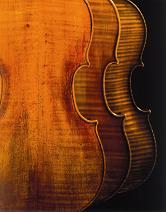
The University of Edinburgh

 |
The University of Edinburgh |  |
| The Edinburgh University
Collection of Historic Musical Instruments with the
British Violin Making Association, is organising a colloquium on the Violin
in Scotland, to be held in Edinburgh, Saturday 26 August 2006.
The Colloquium will present recent research on topics related to the making of violin family instruments in Scotland (all periods) and related aspects of repertoire and the social milieu of violin playing in Scotland. See Full details of the Colloquium and booking information The Colloquium will be followed by a concert given by the Edinburgh Quartet using instruments by Matthew Hardie These events are organised in conjunction with the exhibition Violin Making in Scotland 1750-1950. |
 |

The "Fydill in Fist"Mary Anne Alburger,
|

Electric Violins: A Study of Two Scottish MakersKatherine Campbell,
|

The Scottish Fiddler's MusicCharles Gore,
|

The Hardie Family and their contribution to the Scots Fiddle Tradition as players, arrangers, composers and publishers (c 1775 - 2006)Alastair Hardie,
|

Thomas Erskine, Earl of Kelly, Violinist and ComposerDavid Johnson,
|

Strings in DisguiseJohn Purser,
|

The working methods of Matthew and Thomas Hardie and their influence on the Scottish Violin Making School between 1780 and 1860David Rattray,
|

E-mail euchmi@ed.ac.uk
Write to: Arnold Myers
Collection of Historic Musical Instruments,
University of Edinburgh,
Reid Concert Hall,
Bristo Square,
EDINBURGH EH8 9AG, U.K.
This page updated: 17.7.06; re-published 13.2.13